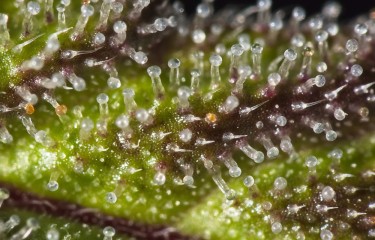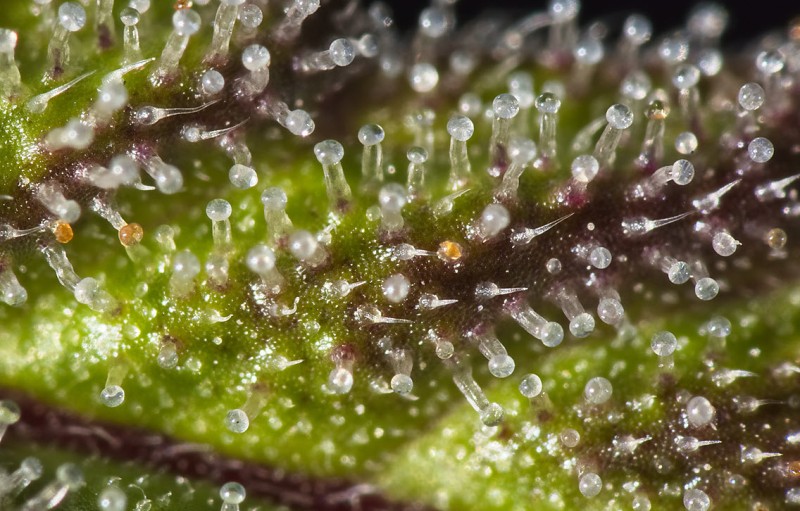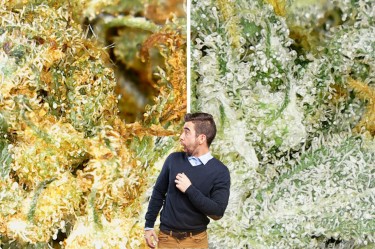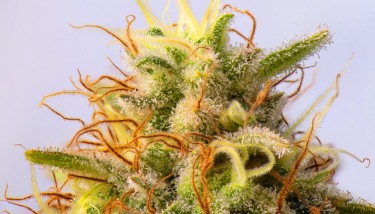
Using Trichomes As An Indicator Of When To Harvest
Having a better understanding of the trichome development timeline is vital in cultivating high-quality cannabis for a balanced experience for users. Trichomes are the sticky outgrowths of resin glands present on the surface of stems, buds, leaves, and stalks of cannabis plants.
Trichomes function as part of a plant's defense system but they are valued for storing and producing aromatic terpenes and cannabinoids like cannabidiol and tetrahydrocannabinol. They are also greatly responsive to the smell, flavor, and effect of cannabis.
At every trichome stage, the cannabis plant is said to contain distinct ratios of cannabinoids. This is why trichomes are considered one of the best methods of identifying when the cannabis plant is ready for harvest.
How to Examine Trichomes
Every grower understands that cannabis cultivation is generally a delicate process. Thus, trichome development must be observed during the plant's flowering period. By observing the opacity and color of trichomes, growers can determine the best harvest time for the specific use of the cannabis plant.
However, many growers find it very difficult to identify when the trichome is clear versus cloudy. No doubt trichomes go through several stages that many first-time growers may not be able to identify. But, they will benefit greatly by referencing harvest charts and trichome color charts of experienced growers.
Naturally, trichomes can be very small, measuring about 10 micrometers, and go grow as big ad 500 micrometers. Due to their small size, trichomes are often observed using magnifying glasses of 30 and 120X magnification. When viewed under the microscope, trichomes look like hairs on the cannabis plant.
However, growers show to look out for mushroom-like trichomes as they contain the majority of the medical and psychoactive compounds. This type of examination helps grows to precisely identify the trichome stage and determine whether or not it is ready for harvest.
Types of Cannabis Trichomes
Three types of trichomes have been generally identified to be vital to the chemical balance and maturity of cannabis plants. Having a clear underlying of these trichome types is very vital to having a successful harvest. These three types of trichomes are capitate-stalked trichomes, capitate trichomes, and bulbous trichomes.
Bulbous Trichomes
Bulbous trichomes are tiny bulbs evenly distributed on the surface of cannabis plants. They contain minute THC and are usually between 10 to 30 micrometers in size. Bulbous trichomes often produce crystal-like sicknesses and sheen which many growers use in identifying high-grade cannabis. These trichomes can dey identified by their unicellular stalks and glad heads that bulge with plant oil.
Capitate Sessile Trichomes
Capitate sessile trichomes are slightly bigger and more abundant than bulbous trichomes. They measure between 25 and 100 micrometers and are also typically visible under her microscope. These trichomes are identified by their mushroom-shaped appearance and are often found on the underside of fan leaves and sugar leaves
Capitate sessile trichomes stimulate cannabinoids all through the lifecycle of cannabis plants. However, not as much as capitate-stalked trichomes. These trichomes are believed to be best suited for cannabis-infused drinks and edible cannabis.
Capitate-Stalked Trichomes
Capitate-stalked trichomes are the most abundant and biggest of the three trichome types. These trichomes also have mushroom-like appearances, with big bulbs on the stock head. These trichomes are visible to the naked eye and are often more abundant in female cannabis plants.
With about 500 micrometers in size, capitate-stalked trichomes continue to grow denser as the flowering stage progresses. This means the development of this trichinosis is vital since they produce more desirable terpenes and cannabinoids.
Stages of Trichome Development
The maturation and formation of trichomes are understood to affect the THC/CBD balance and potency of the cannabis plant. Four stages of trichome development have been identified and growers can tap into this knowledge to produce cannabis products for specific uses — be it recreational or medical purposes.
Every stage of trichome development has a distinct color, and this is why a trichome color chart is a vital reference point for new growers. Depending on the developmental stage, trichomes can appear amber, milky, clear, or even have mixed colors. Let's have a look at each color.
Clear Trichomes
The first sign of transition into the flowering period is the development of clear trichomes on the plant surface. When magnified, the trichomes appear either opaque or clear. At this stage, the plant starts producing THC but it's too early for harvest.
Harvesting buds with clear trichomes gives a less potent and possible uncomfortable user experience. But, a clear trichome on the cannabis plant is an indication of healthy growth.
Milky Trichomes
The formation of cloudy trichomes indicates that cannabis plants are starting to reach ideal flavor and potency. However, the plant is still not fully mature and lacks the rich aroma of cannabis plants. Cloudy or mildly trichomes imply that the plant's THC levels are higher than CBD levels, meaning more prevalent psychoactive effects.
Harvesting cannabis plant at this stage gives users an uplifting experience. Naturally, trichomes are milky for two weeks before developing further.
Amber Trichomes
The development of amber trichomes indicates a shift in THC/CBD ratio. A cannabis plant covered in amber trichomes has higher CBD levels than THC levels. This stage is identified by the absence of tiny white hairs on the bud.
Trichomes at this stage have a brown or dark orange color. Cannabis harvested at this stage gives a sleep-inducing and more relaxing experience for users. The medical industry often tilts towards cannabis plants harvested during this stage as it helps to treat insomnia and manage pain.
Mixed Trichomes
Many cannabis growers usually look for a certain ratio of amber trichomes to cloudy trichomes. A lot of experienced cannabis growers believe that the best time to harvest cannabis is when trichomes are 30% amber and 70% cloudy. Buds harvested with this amber-to-cloudy ratio are usually used in the retail industry to induce cerebral and stimulating effects on recreational users.
Conclusion
Cultivating and harvesting stunning trichomes is a vital part of a profitable harvest. However, those trichomes must be protected and handled with care when processing.
Given the delicate nature of trichomes, preserving them requires careful handling with a solvent-free and dry-sift trichome extractor. The extractor can either operate by adding pulverized dry ice or as a stand-alone machine depending on your budget or style.
As much as harvesting cannabis plants with impressive trichomes are great, protecting them during processing is also important otherwise all your efforts might be jeopardized.
TRICHOME COLORS TO HARVEST, READ MORE...
MAGIC FLOWER SPRAY FOR TRICHOME COLORS AT HARVEST TIME?







